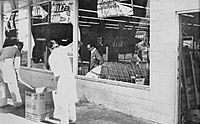Hunters Point social uprising (1966) facts for kids
Quick facts for kids Hunters Point Social Uprising |
||||
|---|---|---|---|---|
| Part of Ghetto riots | ||||
| Date | September 27 – October 1, 1966 | |||
| Location | ||||
| Caused by | Shooting and death of Matthew 'Peanut' Johnson by San Francisco policeman | |||
| Parties to the civil conflict | ||||
|
||||
| Casualties | |
|---|---|
| Death(s) | 1 |
| Injuries | 51 |
| Arrested | 359 |
The Hunters Point social uprising was a series of events that happened in the Hunters Point neighborhood of San Francisco. It started on the night of September 27, 1966. This uprising began after a San Francisco Police Department (SFPD) officer shot and killed Matthew Johnson. Matthew was a teenager who was running away from a stolen car.
Because of the events, the National Guard and California Highway Patrol (CHP) were called in. Governor Pat Brown sent them late that night. A special rule called martial law was put in place until October 1. This meant the military took control of the area.
By 11 P.M. on September 27, police started getting reports. People were smashing windows, taking things from stores (called looting), and causing trouble. These reports came from the Fillmore District. When the first Highway Patrol officers arrived, they helped the SFPD in both the Fillmore and Hunters Point areas.
A rule called a curfew was set up in the Fillmore and Hunters Point neighborhoods. This meant people had to stay inside their homes after a certain time. The Student Nonviolent Coordinating Committee (SNCC) later said these curfew boundaries seemed unfair. They pointed out that one neighborhood, which was mostly white and middle-class, was left out of the curfew area in the Fillmore.
Adjutant General Roderic L. Hill from the California National Guard arrived at SFPD headquarters early in the morning. Candlestick Park and Kezar Stadium were chosen as places for the National Guard soldiers to gather. By 7 A.M. on Wednesday, September 28, the situation was calm. However, calls started coming in at 9:30 A.M. reporting that crowds were gathering again.
What Happened After the Uprising?
In the 128 hours after Matthew Johnson's death, many people were affected. A total of 359 people were arrested. Many of these arrests were for breaking the curfew rules. Also, 51 people were injured during this time. This included 6 police officers, 2 firefighters, and 1 bus driver.
No other people were killed during these events. The damage to property was estimated to be less than $100,000. Another official report, called 128 Hours, said that 457 people were arrested. It also reported that 160 people were injured. This included 58 police officers, 27 firefighters, and 5 other city workers. Two people from the California Highway Patrol were also injured. Among civilians, 69 were injured, and 10 of them had gunshot wounds.
The report also looked closely at the costs. It estimated about $45,063 in property damage. There were also about $90,824 in lost items from stores.
The Legacy of Hunters Point
The Hunters Point Social Uprising was an important event. It was featured in a 1994 play called Our Part of Town. This play was performed at the Bayview Opera House. It was based on stories told by people who lived through the events.




